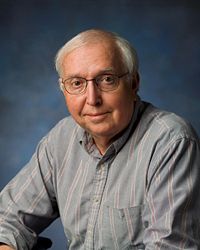
David S. McKay
Encyclopedia

Astrobiology
Astrobiology is the study of the origin, evolution, distribution, and future of life in the universe. This interdisciplinary field encompasses the search for habitable environments in our Solar System and habitable planets outside our Solar System, the search for evidence of prebiotic chemistry,...
at the Johnson Space Center. McKay was the first author of a scientific paper postulating past life on Mars
Mars
Mars is the fourth planet from the Sun in the Solar System. The planet is named after the Roman god of war, Mars. It is often described as the "Red Planet", as the iron oxide prevalent on its surface gives it a reddish appearance...
on the basis of evidence in Martian meteorite ALH84001
ALH84001
Allan Hills 84001 is a meteorite that was found in Allan Hills, Antarctica on December 27, 1984 by a team of U.S. meteorite hunters from the ANSMET project. Like other members of the group of SNCs , ALH 84001 is thought to be from Mars. However, it does not fit into any of the previously...
found in Antarctica. This paper has become one of the most heavily cited papers in planetary science. The NASA Astrobiology Institute
NASA Astrobiology Institute
The NASA Astrobiology Institute was established in 1998 by the National Aeronautics and Space Administration "to develop the field of astrobiology and provide a scientific framework for flight missions". The NAI is a virtual, distributed organization that integrates astrobiology research and...
was founded partially as a result of community interest in this paper and related topics.
Lunar dust
McKay has studied lunar dust since the return of the first Apollo 11Apollo 11
In early 1969, Bill Anders accepted a job with the National Space Council effective in August 1969 and announced his retirement as an astronaut. At that point Ken Mattingly was moved from the support crew into parallel training with Anders as backup Command Module Pilot in case Apollo 11 was...
samples in 1969, and has contributed over 200 publications on this topic. As a result of this effort, McKay has contributed major discoveries, including:
- Source of vapor deposition on lunar soil grains
- Formation of nano-phase iron globules on lunar soil grains
- Processes on the Moon that contribute to grain size distribution
- Space weathering and chemically activated nature of in-situ lunar dust
Space resources and planetary materials
McKay has published numerous papers and abstracts relating to planetary materials and space resource utilization: lunar regolithRegolith
Regolith is a layer of loose, heterogeneous material covering solid rock. It includes dust, soil, broken rock, and other related materials and is present on Earth, the Moon, some asteroids, and other terrestrial planets and moons.-Etymology:...
, cosmic dust, meteorites, Martian soil analogs, and technologies for producing oxygen, water, and building materials from lunar soil.
Lunar simulants
The engineering simulant JSC-1 was developed by McKay, James Carter of The University of Texas at Dallas, and others.Controversy
In 1996, McKay's team published their findings regarding possible microfossil structures in Martian meteorite ALH84001. McKay has presented more than 100 talks at scientific and public gatherings on the possibility of life on Mars and the implications of that possibility.Asteroid Davemckay, #6111
McKay was honored by the International Astronomical Union (IAU) by having an asteroid named after him in 2002. His IAU citation mentions his years of work on lunar samples as well as the positive effect his research on Martian meteorites has had on planetary research.“It was an unexpected but very high honor to have an asteroid named after me,” McKay said. “If it ever crashes into Earth, I will probably get the blame, but in the meantime it is very nice to have it out there orbiting the Sun for perhaps the next few billion years.”
Education
- Rice University, B.A., Geology, 1958
- University of California – Berkeley, M.A., Geology, 1960
- Rice University, Ph.D., Geology, 1964
Current
- 1996 – present: Chief Scientist for Astrobiology and Planetary Science and Exploration
NASA Johnson Space Center, Houston, TX 77058
Previous
- Assistant for Exploration and Technology – NASA Johnson Space Center, 1994 – 96
- Chief, Planetary Programs Office – NASA Johnson Space Center, 1991 – 94
- Chief, Mission Science and Technology Office – NASA Johnson Space Center, 1990 – 91
- Chief, Space Resources Utilization Office – NASA Johnson Space Center, 1987 – 90
- Staff Scientist – NASA Johnson Space Center, 1965 – 87
- Exploration Geophysicist, Exxon and Marine Geophysical, 1960 – 61
Honors
- Outstanding Graduate Student Award, Rice University Geology Department, 1963
- Certificate of Special Commendation for Astronaut Training in Geology, Geological Society of America, 1973
- NASA Superior Achievement Award for Lunar Science Contributions, JSC, 1973
- Visiting Scientist Fellowship, Government of Japan, 1974 – 75
- NASA Principal Investigator Recognition Award, 1979
- Multiple Outstanding Performance and Sustained Superior Performance Awards by NASA
- Eight Group Achievement Awards: Field Geology Training Team, Lunar Science Team, Lunar Landing Team, Lunar Surface Experiments Team, First Lunar Outpost Team, Orbital Debris Team, Planetary Materials Curation Team, and Mars Life Public Affairs Team
- Laurels Award, 1996, by Aviation Week and Space Technology
- Life on Mars Team awarded Rotary National Stellar Award for Space Achievement
- Life on Mars Team awarded Popular Science Magazine Award: The Best of What’s New: Grand Award Winner
- NASA Exceptional Scientific Achievement Medal (NASA’s highest award for science), July 1997
- Distinguished Texas Scientist Award, 2000, The Texas Academy of Science

